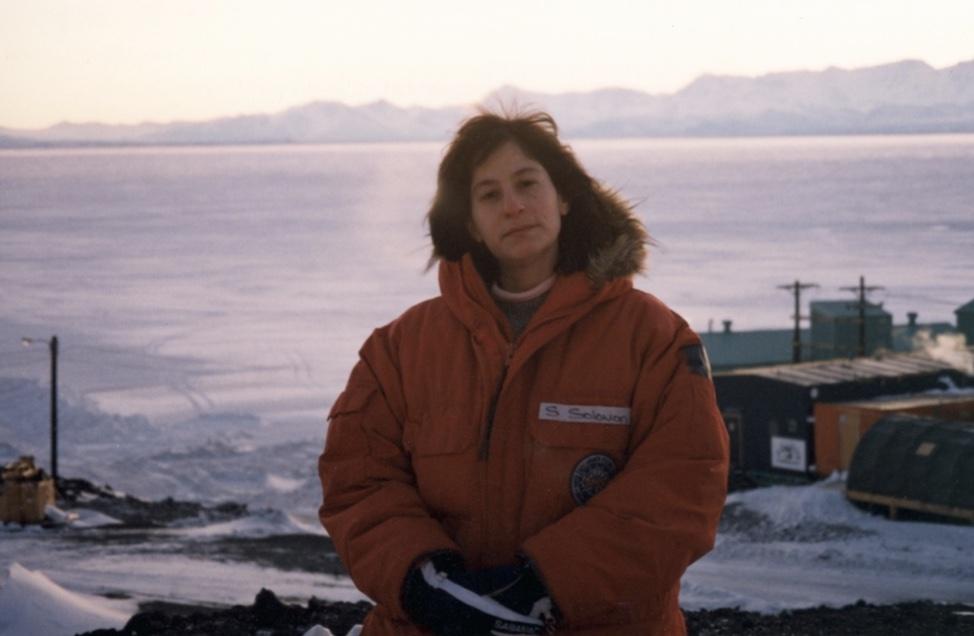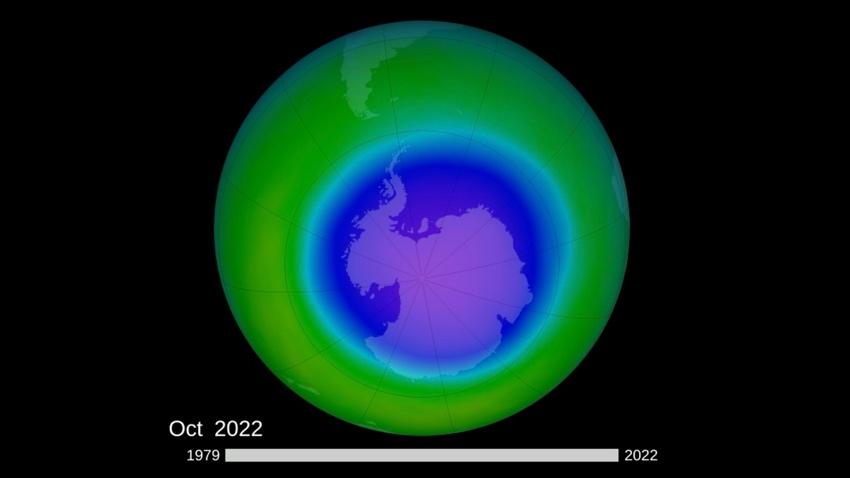Yves here. See, we’re not all gloom and doom! A positive climate development!
By Bob Henson. Originally published at Yale Climate Connections
A treaty adopted 35 years ago and meant to solve an entirely different problem is also protecting the climate. And with bipartisan support from the Senate and President Joe Biden’s Oct. 26 signature, the U.S. became the world’s 139th nation to adopt a key amendment to that agreement — the first time the U.S. has joined a legally binding global measure specifically to combat climate change.
What is the Montreal Protocol?
Global warming was on the back burner in 1985 when scientists from the British Antarctic Survey found a gaping hole in the planet’s stratospheric ozone layer. A natural feature of the atmosphere, the ozone layer is located between about 10 to 25 miles above Earth’s surface. It shields the planet from the sun’s ultraviolet radiation, which is harmful in large doses to our skin and to myriad other aspects of plant and animal life.
Researchers rapidly pinned down the cause of the ozone destruction: chlorofluorocarbons, known as CFCs, which are chemicals used as refrigerants and to manufacture aerosol sprays and other materials. CFCs had been recognized for years as a threat to the ozone layer, but the ozone hole found in the mid-1980s was far worse than anything expected by that point.
By 1987, diplomats had crafted a treaty known as the Montreal Protocol to fix the problem. It was an immense success, ratified by every member state of the United Nations.
There was a major catch, though.
Both CFCs and their leading replacements – hydrofluorocarbons, or HFCs – trap heat in the atmosphere, causing global warming.
Atmospheric chemist Susan Solomon led crucial research that found CFCs were reacting with polar stratospheric clouds to destroy ozone above Antarctica. In an email, Solomon pointed out that CFCs were recognized as dangerous heat-trapping gases as far back as the mid-1970s. Once released, they remain in the atmosphere for about a century.
HFCs have much briefer atmospheric life spans – on the order of a decade or two. So they were “rightly viewed as less damaging both for ozone and climate and as a transition substance,” Solomon said.
“What changed was that the developing countries began to develop far faster than originally expected,” Solomon said, “which made the world realize that demand for these molecules would shoot up rapidly as the number of people using refrigeration and [air conditioning] would increase in the 21st century.”
And it soon became clear that a large volume of HFCs could do plenty of damage.

What is the Kigali Amendment and Why Did the U.S. Senate Support It?
Enter the Kigali Amendment.
Adopted at a United Nations meeting held in the Rwanda capital in October 2016, it uses a variety of policy approaches to throttle back on both the production and consumption of HFCs. The amendment has put the world on track to eliminate more than 80% of HFCs by midcentury.
One reason the Kigali Amendment passed the Senate with bipartisan support (69-27, including 21 of the chamber’s 50 Republicans) is that national action on HFCs along the lines of Kigali was already in gear. The pandemic stimulus bill of late 2020 specified an 85% cut in HFC production by 2030. Many lawmakers, especially those from states with major chemical manufacturing, had recognized that cutting HFCs made sense. For one thing, nations that have not ratified the amendment cannot trade HFCs with those that have.
Bringing down HFCs is an undisputed climate win. If HFCs were to grow at an uncontrolled pace, as they were doing just 20 years ago, they could add close to 0.5 degrees Celsius (0.9 degrees Fahrenheit) to the amount of global heating expected by 2100.
“I think U.S. ratification of Kigali shows that there is no fundamental barrier to stepping up ambition on greenhouse-gas reduction,” Solomon said. “If we can do it with today’s fractured Congress, we can do other things too, like carbon-dioxide reduction.”
How the Montreal Protocol Has Protected Earth’s Climate
But the phaseout of HFCs is not the only way the Montreal Protocol is helping the climate. The climate benefits of the Montreal Protocol gained prominence in a series of “world avoided” papers published starting in 2007.
In all, researchers have found that roughly 2.5°C(4.0°F) of warming by 2100 is being averted by aspects of the Montreal Protocol unrelated to HFCs. Much of that avoided warming results from the protocol’s phaseout of CFCs.
In addition, had the world chosen not to ratify the Montreal Protocol and instead continued to damage the ozone layer, plants would have been harmed by extra ultraviolet sunlight. That would have reduced their ability to remove heat-trapping carbon dioxide from the atmosphere and led to still more warming, according to a 2021 paper.
“So far, the Montreal Protocol has protected climate more than all other efforts combined,” said Stephen Andersen, director of research at the Institute for Governance and Sustainable Development in Washington, D.C., in an email. Andersen is co-author of a special volume, issued jointly on Oct. 31 by the institute and the United Nations Environment Program, that commemorates the protocol’s 35th anniversary.
“The rapid transition from an ozone treaty also protecting climate, to a hybrid ozone and climate treaty with future emphasis on climate, is an amazing diplomatic and environmental success,” Andersen said.
More Pollutants To Tackle
HFCs are a classic example of what are known as short-lived climate pollutants. It takes well more than a century for an atmospheric infusion of carbon dioxide to work its way back into the oceans and soil. Molecule for molecule, carbon dioxide is not an especially powerful heat-trapping gas, but it’s emitted in titanic amounts — more than 30 billion metric tons per year. Because of this sheer volume combined with its longevity, carbon dioxide is expected to cause the bulk of global warming this century and beyond.
Short-lived greenhouse gases – most prominently methane, but also nitrous oxide and several others, including HFCs – pack a much more intense punch per molecule than carbon dioxide. The global warming potential of an HFC molecule is more than 10,000 times that of carbon dioxide when the effects of both are summed over a century-long span. This effect is counterbalanced by HFCs being far less prevalent than carbon dioxide.
Many scientists, activists, and diplomats are pushing for prompt action on other short-acting pollutants in addition to HFCs, especially methane. Since these gases tend to be so powerful over the short term, cutting them ASAP would provide immediate help, they argue.

Lessons from Montreal and Kigali
Durwood Zaelke, president of the Institute for Governance and Sustainable Development, is optimistic that headway on other short-term pollutants is possible, with the Montreal and Kigali agreements serving as important inspirations. The agreements “show we have won the battle before,” he said. “Now let’s get the whole package of short-term pollutants under regional agreements.”
Methane from fossil fuels is particularly ripe for reduction, Zaelke said. Huge amounts of natural gas are lost through pipeline leakage or burned off in flares. “You can do at least 50% of methane recovery in oil and gas at a profit,” said Zaelke. At this point, he added, “the oil and gas sector understands that to keep their social license they’re going to have to have very low leak rates.”
A Global Methane Pledge introduced in 2021 advocates for a cut of 30% in worldwide methane emissions from 2020 to 2030. This pledge now includes more than 120 countries; together, they represent about 45% of global methane emissions and around 60% of global GDP.
Solomon says that the same practical approach employed by the Montreal Protocol – crafting policies that stimulate new, cost-effective technologies – can be used for carbon dioxide as well.
“Misinformation has led many people to believe it can’t be done or would be enormously expensive for CO2. That is certainly not true now.”


Got to “love” how it took USA 6 years to sign that amendment into law.
As i understand it, there are a number of treaties that US presidents have “signed” that has never been made law by congress and thus do not affect USA to this day.
But from what I understand HFCs don’t have the same economic significance as fossil fuels, so not even remotely the same level of interests are affected, so not even remotely the same level of resistance exists. It’s relevance as a model is therefore not very clear to me.
That’s correct. White’s law is key. It’s about energy not global warming gasses: “culture [read industrialization] evolves as the amount of energy harnessed per capita per year is increased, or as the efficiency of the instrumental means of putting the energy to work is increased”
Often there is not an or but an and, as seen with Jevons paradox.
Efficiency increases, resulting in the drop of value of the input, that in turn increase total usage as previously unprofitable uses become profitable.
In the end CO2 from hydrocarbons are unlikely to halt until the cost of extraction make potential uses unprofitable.
Exactly! I guess everyone has given up on CO2 reduction so we’re now supposed to celebrate tiny wins that were mostly won almost 40 years ago. One of my classes or books I read pointed to Montreal as an example, but it’s not only just a tiny industry compared to (literally everything ever emits CO2), it’s also the case that they could quickly develop alternative chemistries. To be honest, the fact that we didn’t also immediately ban HFC production and quickly draw down it’s use in 3rd world countries by subsidizing the replacement is a hugely pathetic.
So 50% of methane can be recovered, rather than emitted to the atmosphere. Where does this recovered methane go? To making plastics? I don’t see how that is good news.
Production of hydrogen is one use for captured gas:
https://www.energy.gov/eere/fuelcells/hydrogen-production-natural-gas-reforming
https://www.pnnl.gov/news-media/new-clean-energy-process-converts-methane-hydrogen-zero-carbon-dioxide-emissions
https://aurorahydrogen.com/
Donnie Darko can’t hold his tongue.
We have nearly doubled global population since then, simple logic would indicate we are simply using 2x as much of everything. Back of the napkin, refutable, but even so, there are more problems looming than hard fought protracted resisted solutions arriving. As a human bean in America, I am a big part of the problem.
I liked that term ‘social license’ used for Oil and Gas producers. I often speak to clients about the good citizen side of Oil and Gas, and reputational damage, which in a perfect world will keep things positive of neutral —fully knowing in the back of my mind it is way down on the greaseballs list of priorities.
99.99% of us are using oil and gas or carbon-based electricity every day. I am in Crowdorado in the front range and heard on local NPR blah blah feed there is a 12K acre development area in Aurora that is working with O & G producers for approximately 180 O & G Wells, to operate, or to be drilled and developed, in neighborhoods.
Amazing stuff. https://coloradotimesrecorder.com/2022/10/proposed-oil-gas-development-ignores-cumulative-impacts-of-pollution/49296/
I know there is good news, and it is great to see it. If we want change, we each need to make the change. Waiting for 35 years for governments, shackled by industry money, lobbyists, and blocking… well
Check out book Ministry for the Future. Great timely read regarding pace of change on pressing global environmental matters.